Peter Kudla & Michelle Sie Whitten featured on Colorado & Company segment discussing the Be Beautiful Be Yourself Fashion Show
October 20th, 2017 by Global Down Syndrome Foundation
We Keep Working
October 20th, 2017 by Global Down Syndrome Foundation
The Ankar Family Of Chattanooga, Tennessee, Has Achieved Their American Dream. Now, The Next Generation Is Using The Secret Of The Family’s Success — A Relentless Work Ethic — To Carry That Dream Forward.
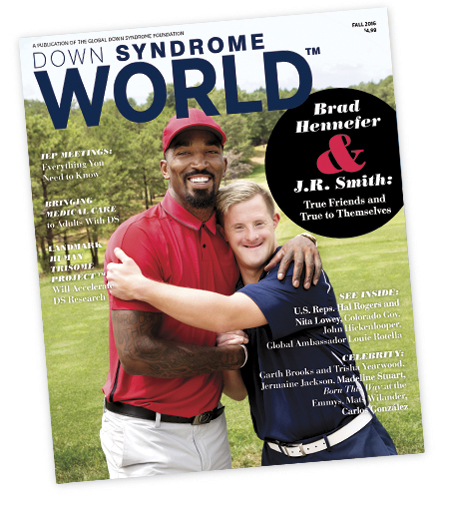 This article was published in the award-winning Down Syndrome World™ magazine. Become a member to read all the articles and get future issues delivered to your door!
This article was published in the award-winning Down Syndrome World™ magazine. Become a member to read all the articles and get future issues delivered to your door!
Twenty-one-year-old Andrew Ankar, who has Down syndrome, cheerfully shoulders the responsibility of Ankar’s Hoagies, a family restaurant chain serving Middle Eastern and American food started by his late father in 1979. He and his mother, Judy, arrive by 8:15 every morning and don’t leave until 9:30 at night. Andrew works wherever he’s needed, whether it’s manning the grill or greeting customers.
“Burgers are my favorite thing to make,” he said. “I ask how the customers are doing. When it gets really busy, we keep working. All the hard work is worth it.”
ALL IN THE FAMILY
As soon as George Ankar, an immigrant from the Palestinian West Bank, opened the first Ankar’s Hoagies 37 years ago, it became a popular local staple and grew entirely by word of mouth — the family has never spent a cent on advertising — to include two locations.
When George lost his battle with cancer in 2015, he left the business to his two sons. Older brother Alex, a medical school student, has little time to devote to the restaurant and therefore is happy to leave Andrew in charge.
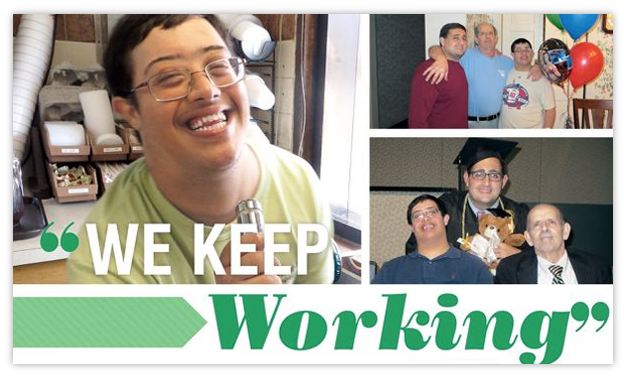
“Dad always said, ‘Take care of your mom and your brother,’” Andrew explained. “I do. I work hard, like Dad. I want to make him proud.”
IN THE PUBLIC EYE
Earlier this year, a customer complained to the local health department about Andrew’s being allowed to prepare food. Judy was furious. Alex, in a Facebook post defending his brother that was shared 7,000 times, said the complaint “made his blood boil.”
Andrew, however, took it in stride.
“He said, ‘Mom, stop,’” Judy said. “He was telling me to get over it, that it w as no big deal. I thought about not letting the customer back in, but that’s not whatAndrew would do.”
The incident was a reminder that progress never comes easy, but the Ankars won’t stop working for it. “Life has been good,” Judy said. “It’s been hard, but it’s been really good.”
PLAYING FAIR
When Andrew was born, Judy Ankar’s grandmother in Jerusalem told her, “We never see things like this. Kids aren’t born that way.” Hearing that, Judy knew she was going to have to fight to overcome entrenched stereotypes and make sure
Andrew had a fair shot in life.
“I never treated Alex and Andrew differently,” Judy said. “I wanted them to know they were equals. Now, they’re not that different. Andrew was a bit slower in learning. Sometimes, though, he could run circles around his brother. I used to joke that Alex is book smart, but Andrew is common sense smart.”
Like this article? Join Global Down Syndrome Foundation’s Membership program today to receive 4 issues of the quarterly award-winning publication, plus access to 4 seasonal educational Webinar Series, and eligibility to apply for Global’s Employment and Educational Grants.
Register today at downsyndromeworld.org!
Global announces $2.5 million joint contribution in groundbreaking Down syndrome-Alzheimer’s disease
October 18th, 2017 by Global Down Syndrome Foundation
Global Down Syndrome Foundation announces new collaboration for groundbreaking Down syndrome – Alzheimer’s disease research project
October 18th, 2017 by Global Down Syndrome Foundation
$2.5 million initial commitment to launch project
DENVER –The Global Down Syndrome Foundation today announced that Biogen, a neuroscience leader has joined the Global Down Syndrome Foundation and the University of Colorado School of Medicine in a groundbreaking project that explores the connection between Alzheimer’s disease and Down syndrome.
The Crnic Institute Human Trisome ProjectTM (HTP) is an ambitious longitudinal and cross-sectional study that will recruit 1,000 individuals with Down syndrome (also known as Trisomy 21) and 500 typical individuals. Scientists and clinicians will sequence and study several layers of genomics information (all de-identified) from a single sample of blood. Saliva, stool and other samples are also being collected. The Crnic Institute HTP has already begun to significantly increase the speed of Down syndrome research and has enrolled nearly 300 participants in the first 11 months.
“People with Down syndrome have a different disease spectrum,” said Dr. Joaquín Espinosa, executive director of the Crnic Institute, and the principal investigator of the Crnic Institute HTP. “The Crnic Institute HTP will allow us to redefine Down syndrome from the least scientifically understood condition to one of the best understood conditions. In addition, it will provide unprecedented understanding of Alzheimer’s disease, autoimmune conditions, cancers and other medical conditions that people with Down syndrome are either very predisposed to or protected from, eventually enabling the development of new diagnostic and therapeutic tools.”
“This research will serve first and foremost people with Down syndrome, but also the millions of individuals without Down syndrome who are affected by the many medical conditions modulated by trisomy 21,” said Espinosa.
Biogen has committed more than $500,000 and additional in-kind resources to the Crnic Institute HTP to investigate the genome and epigenome of specific cell types in the blood that could inform the development of Alzheimer’s disease. This initial investment is being financed with funds from Biogen and $1 million from the University of Colorado School of Medicine at the Anschutz Medical Campus – home to the Linda Crnic Institute for Down Syndrome – with a matching gift of $1 million from the Global Down Syndrome Foundation.
“Down syndrome is still one of the least funded genetic conditions of the federal government, so we are extremely grateful for the commitment from CU and Biogen,” said Michelle Sie Whitten, president & CEO of the Global Down Syndrome Foundation. “This is just the beginning as we hope to attract other biopharmaceutical organizations and philanthropists committed to improving the lives of people with Down syndrome and other conditions.”
“The School of Medicine provides a home for outstanding biomedical research that leads to improved care for all,” said Dr. John J. Reilly, Jr., vice chancellor for health affairs and dean of the University of Colorado School of Medicine. “We are confident that this investment will have a significant impact on our understanding of the health of people with Down syndrome and that it will lead to discoveries informing the care we provide.”
“Our son is 38 years old and we are concerned that he may get Alzheimer’s,” said Jack and Penni Dorwart, whose son participated in the Crnic Institute HTP. “We also know that if we have high- quality research that there is the potential to significantly improve not only our son’s life but millions of others with Down syndrome who have many other medical issues that prevent good quality of life. That is why we participated in this study and we encourage others to do the same. We are grateful to the Crnic Institute and the Global Down Syndrome Foundation for taking on this difficult work and advocating for our children and adults.”
Learn more about in the Crnic Institute Human Trisome ProjectTM or sign up to participate in the study.
October 2017 Newsletter
October 17th, 2017 by Global Down Syndrome Foundation
Eva Longoria and Jamie Foxx will rock Global’s runway, a $2.5 million contribution to Down syndrome research, and more!
Down Syndrome Awareness Oct
October 15th, 2017 by Global Down Syndrome Foundation
A Model Family with Fashion Model Amanda Booth
October 13th, 2017 by Global Down Syndrome Foundation
Fashion Model Amanda Booth And Her Husband, Photographer And Creative Director Mike Quinones, Are No Strangers To The Camera — Which Is Why They Decided The Best Way To Advocate For Their Son, Micah, Was To Stay In Front Of One.
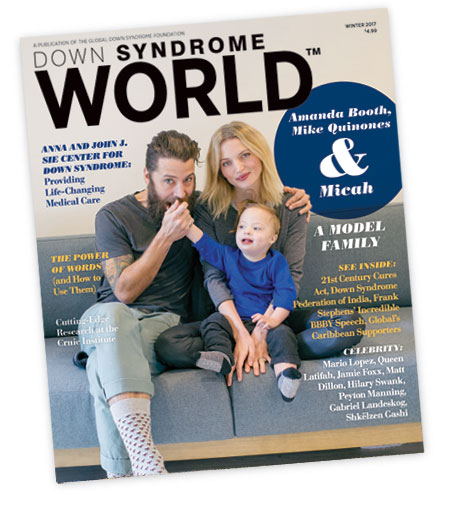 This article was published in the award-winning Down Syndrome World™ magazine. Become a member to read all the articles and get future issues delivered to your door!
This article was published in the award-winning Down Syndrome World™ magazine. Become a member to read all the articles and get future issues delivered to your door!
TWO YEARS AGO, Amanda and Mike were globe-trotting creative types — she, modeling in Lancôme commercials with Julia Roberts, photo essays in GQ U.K., and ad campaigns for Target and True Religion, among dozens of other brands, and he, a creative director and brand strategist — when they decided to start a family.
“I have six siblings, five of whom are younger than me,” Amanda said. “I couldn’t wait to have my own child, and I knew I was going to be a good mother.”
“When Amanda told me she was pregnant, I instantly felt a change,” Mike added. “There is nothing else that gives that sense of responsibility and honor. Bringing life into this world is an amazing commitment.”
AN EMOTIONAL PATH
Amanda’s pregnancy began, as most do, with excitement. She and Mike created an Instagram account so they could share their nine months of waiting with friends, family, and fans, and Amanda even scored a modeling contract with a maternity line called Wildfox.
However, things started to “go wrong,” as she recalled, toward the end. The couple had made plans for a home birth, but ultrasounds in the last few weeks revealed that Micah had a weak heartbeat and wasn’t growing as he should be, both of which concerned Amanda’s midwife and doctors. Worried her son might be suffering from a serious health issue, she agreed to be induced and give birth in a hospital. It was not a decision she or Mike relished.
After Micah’s birth, as the new family was bonding in the recovery room, the on-call pediatrician stopped by and asked if they had done genetic testing. The doctor told Amanda and Mike she suspected- Micah had Down syndrome.

“We’d just had this intense birth, not how I wanted it to be, and we had this tiny baby who was not even five pounds,” Amanda said. “She just comes in and blurts this out.”
The doctor had seen Micah’s slanted eyes, which Amanda attributed to Mike’s part-Mexican heritage, and folded ears, which Amanda suspected might have come from Micah being growth-restricted in the womb. But the doctor wanted to confirm the diagnosis. Still recovering from heightened emotions of the birth and feeling overprotective of her new infant, Amanda didn’t want to subject Micah to having four vials of blood drawn, a requirement of genetic screening.
“We did an echocardiogram knowing 50 percent of babies with Down syndrome have a heart defect,” Amanda said. “Micah didn’t have one, so we felt relieved that the doctor was probably wrong.
At that point, we were medically cleared to go home, so we did.”
Nevertheless, during Micah’s three-month checkup, his pediatrician noticed he had low muscle tone and reiterated that first doctor’s suspicions that Micah had Down syndrome. This time, Amanda and Mike agreed to the screening. The results were positive.
“I think, on some level, we always knew Micah had Down syndrome,” Amanda said. “We should have found out for sure much sooner, but when you don’t know about something, it’s scary. I think that’s why we waited. Knowing what we know now about Down syndrome and life with a child who has it, we realize there wasn’t anything to be afraid of.”
FINDING A COMMUNITY
During those initial months after Micah’s diagnosis was confirmed, Amanda began gravitating to Instagram to learn from other families whose children have Down syndrome.
“I figured, what better way to learn about something than from another person?” she said. “I instantly fell in love with the babies I was seeing, their encouraging parents, and the love they were sharing. I needed to be a part of that.”
She and Mike began sharing their own family pics depicting everyday life at home, such as enjoying the pool or brushing teeth together, and before long, Micah’s fame was growing as fast as his mother’s. His Instagram feed, @lifewithmicah, eventually gained more than 52,000 followers.
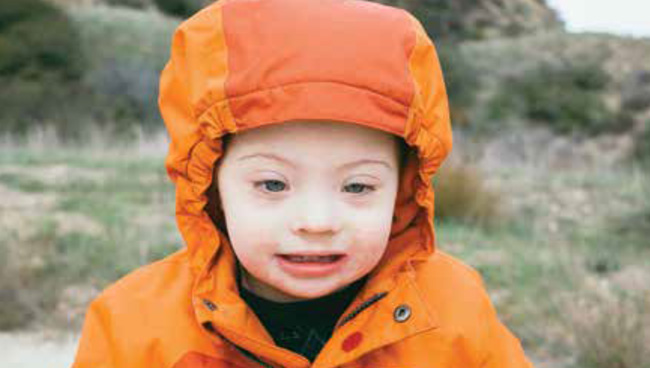
“Mike and I are doing what everyone else is doing: taking photos of our child, sharing them with the world, and hoping someone will write back and say, ‘Your son is adorable,’ and spark a conversation,” Amanda said. “Sharing our story is a way to let other parents and families in the Down syndrome community know we’re all in this together.”
AT HOME WITH MICAH
Now 2 years old, Micah is a warm, rambunctious, food-loving, outdoorsy toddler. Amanda, Mike and Micah’s pediatrician have found a daily regimen of medications to help combat hypothyroidism and vitamins to bolster his immune system. Physical and speech therapy sessions help him build fine motor and communication skills.
“A perfect day for Micah includes running around and watching Elmo’s World,” Amanda said. “He goes to preschool in the morning, has lunch at home, and then attends a one hour therapy session. He doesn’t nap, so we keep him busy during the rest of the day. He loves being in the water, whether it’s in the pool, ocean, or bathtub. He’ll even spill a drink intentionally just so he can splash it everywhere.”
Balancing their careers and parenthood can be difficult for Amanda and Mike, who now works as global creative director for the tech accessory company Incase. But that just makes the everyday family moments they spend with Micah even more valuable.
“We really enjoy spending time outside as a family, whether we’re mountain biking or going on a hike,” Mike said. “We tow him behind our mountain bikes in his carrier — he wasn’t too sure about riding in his carrier deep into the Angeles mountains at first, but he’s really warmed up to it now.”
The busy parents are grateful for the presence of Amanda’s mother, MaryAnn Wylam, who quit her job and moved across the country to help her daughter and son-in-law care for Micah.
“My mother keeps the wheels of this family turning,” Amanda said. “I’m able to pursue my dreams and my career because I know he’s being well cared for. None of this story would seem as magical without her help.”
THROUGH A MOTHER’S LENS
The lines between the most important threads of Amanda’s life — motherhood, advocacy, and modeling — often blur. Amanda and Micah have appeared together on the cover of Parents magazine and in photos for clothing company Dôen. Mike joined them in photos for Sakura Bloom, which makes baby slings.
The entire family has been featured in People, Harper’s Bazaar, and Mother magazines and numerous online blogs. Amanda and Mike see any opportunity for Micah to take the spotlight — Micah has gone on a few modeling auditions of his own, and according to Amanda, loves being photographed — as a way to break down barriers and stereotypes.
“When Micah is included in a photo shoot, that’s advocacy,” she said. “It means companies aren’t afraid to feature someone with Down syndrome.”
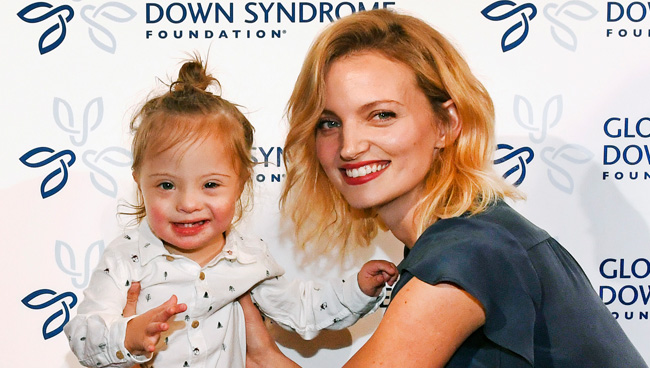
“Our path as parents forked after Micah was diagnosed,” Mike said. “We had to choose between living in fear of Micah’s future or helping him define it. We chose the latter by agreeing to not let standards and expectations prevent us from presenting opportunities and choices to him.”
Modeling also affords Amanda the opportunity to speak out for the Down syndrome community as a whole.
“It’s a gift that I’m able to be a voice for this community because of my child,” she said. “I’m lucky that I’m heard and people are interested in what I have to say, and it’s my duty to make sure I do my best to keep that going.”
You can follow the adventures of Micah (@lifewithmicah), Amanda (@amanda_booth), and Mike (@mikerunt) on Instagram.
SHARING HER EXPERIENCE
Model Amanda Booth and her husband, Mike Quinones, opted to forgo prenatal testing when they were pregnant with Micah. Since Amanda was younger than age 35, the age at which the chances a mother might have a child with Down syndrome begin to significantly increase, they knew the results of a prenatal test wouldn’t have made them want to terminate the pregnancy and didn’t expect the test to reveal anything.
“I realize now that a lot of people like to just have information,” Amanda said. “For those people who decide to test, I believe strongly that the correct and current information needs to be accessible.”
Amanda has become an ambassador for the Down Syndrome Prenatal Testing Pamphlet, a joint publication of the Global Down Syndrome Foundation and National Down Syndrome Congress. Available as a free download at downsyndrometest.org, the publication provides accurate, concise information that helps parents who are considering or have had prenatal testing make informed decisions for their children.
“I hope to get the pamphlet into as many hands as possible,” Amanda said. “There’s no reason women shouldn’t receive the most up-to-date information about Down syndrome.”
FASHION (SHOW) FORWARD
Nowadays, Amanda Booth is more selective with the modeling jobs she chooses because she wants any time away from Micah to feel worthwhile.
But this past November, there was one gig she had no qualms about taking: walking the runway alongside two models in the Global Down Syndrome Foundation’s 2016 Be Beautiful Be Yourself Fashion Show.
“It was so much fun,” Amanda said. “I’ve modeled for a long time, and I try not to take it for granted because it’s something others dream of doing. The excitement the children got from walking the runway reminded me of that. I hope my son can be in the show one day.”
Amanda and her husband, Mike Quinones, used their connections in the fashion industry to obtain some of the clothes the models showed off during the event, and they plan to do so again next year.
“What’s been the most rewarding about working with Global has been seeing the walls they’ve steadily been breaking down,” Mike said. “I’d love to see this event in new cities throughout the world so they can continue breaking down those walls.”
Like this article? Join Global Down Syndrome Foundation’s Membership program today to receive 4 issues of the quarterly award-winning publication, plus access to 4 seasonal educational Webinar Series, and eligibility to apply for Global’s Employment and Educational Grants.
Register today at downsyndromeworld.org!
A GLOBAL Bromance With NBA Champion J.R. Smith
October 13th, 2017 by Global Down Syndrome Foundation
From Issue Fall 2016
NBA Champion J.R. Smith And Accomplished Athlete And Self-Advocate Brad Hennefer Are Proof Positive That No One Should Judge A Book By Its Cover.
One of Brad Hennefer’s favorite sayings is a tagline often repeated in the Down syndrome community: “We’re more alike than different.” It certainly applies to 6-foot-6-inch J.R. Smith and 5-foot-10-inch Brad Hennefer. They’re athletes, change agents — and two people whose first impressions tell a fraction of their stories.
J.R., 31, a guar d for the NBA championship-winning Cleveland Cavaliers, has a tow ering physique, sports tattoos, and is often judged by the national media due to his out ward appearance. But, when not in the public eye, he devotes himself to family and friends. Brad, 27, who has Down syndrome, would appear to be a quiet and unassuming sports fan you’d expect to see in the stands, not setting records on the fairway during the Special Olympics USA Games or breaking down barriers as the first student with Down syndrome in the United States to letter in two high-school varsity sports.
 This article was published in the award-winning Down Syndrome World™ magazine. Become a member to read all the articles and get future issues delivered to your door!
This article was published in the award-winning Down Syndrome World™ magazine. Become a member to read all the articles and get future issues delivered to your door!
Yet when these two good friends are together, as they were for a friendly game of golf on a r ecent summer day, they show their true colors — friends who love sports and, even more, love to see each other succeed. J.R. and Brad, joked, laughed, and talked sports on the green, where their friendship first took root.
SPECIAL BOND
Nine years ago, during a chance encounter at a casino in Atlantic City, New Jersey, their fathers, Earl Smith, Jr., and Bob Hennefer, started talking sports and families. The conversation ended with Earl inviting Bob to bring Brad, who was already a star on his high school’s varsity golf and basketball teams, to the annual J .R. Smith Youth Foundation golf tournament to benefit underprivileged and differently-abled children.
Brad’s golf prowess was eye-opening to the Smiths.
“Brad was surreal,” Earl said. “We didn’t see his disability. We just looked at him as a person.”
From the moment J.R. and Brad met, they had a connection and, over the years, became really close friends.
“People tend to look at those with Down syndr ome differently,” J.R. said. “But ever since I met Br ad, I’ve just seen him as Br ad. He’s a fan of mine and loves me for what I do, but he loves me as a person, too .”
The two see each other often. Br ad attends as many of J.R.’s games as he can and had no difficulties shifting his team loy alties from the New York Knicks to the Cleveland Cavaliers when J.R. was traded during the 2014–2015 season. They talk on the phone regularly, play video games at J.R.’s house, and, of course, they golf.
“Brad loves to have fun,” J.R. said. “He happens to be a hell of an athlete, too. If he hits a bad shot, he just hits another and keeps playing. He understands everything is not going to fall in his lap . He works for it.”
“J.R. is a great man, and we’re great friends,” Brad said. “He’s a goodathlete and a good person.”
DRIVEN TO COMPETE
Throughout their friendship, Brad has gotten to know the J.R. Smith the American public doesn’t always get to see — a man who may appear to have a rough exterior but remains committed to his friends and family and to making sure everyone around him has a fair shot at success.
“I started playing basketball at age 3, when my dad put a ball in my crib,” J.R. said. “I always set my goals toward sports. From the time I understood what the NBA was and watched Michael Jordan and the other players, I wanted to be like those guys. I always believed I’d have an opportunity if I worked hard enough.”
A highly rated prep prospect from suburban New Jersey, he entered the NBA out of high school in 2004 . His professional journey has included playing for the New Orleans Hornets, Denver Nuggets, New York Knicks, and most recently, Cleveland Cavaliers. Nevertheless, his career has had its share of bumps.
Early in his NBA career, J.R. sometimes clashed with coaches, endured suspensions, and fought perceptions of underachievement and a bad-boy persona. He knows he’s not the person some may think he is.
“I’ve been through a lot, but I don’t let that deter me f rom being who I am,” he said. “People can say what they want to say about me until they meet me and talk to me . I’m just a family guy who likes to hang out with my wife, kids, parents, and siblings, and I work hard. I just like to express myself in different ways, like getting tattoos. I’m just me.”
Earlier this year, J.R. reached the pinnacle of his profession when the Cleveland Cavaliers made history by overcoming a three-gamesto-one deficit to defeat the Golden State Warriors for the NBA championship.
“It was the highlight of my life, other than having kids and getting married,” he said. “To actually achieve something that w as always my goal has been unbelievable. It’s something I truly cherish.”
Even that victory was overshadowed somewhat by his larger-than life personality, when photos of him celebrating shirtless at nightclubs and on an airplane circulated through cyberspace and attracted the attention of bloggers, paparazzi, and even President Obama.
“People can look at you a certain way, but with hard work and dedication, you can do anything you want to do,” J.R. said. “Don’t let anyone say you can’t do something — that’s what Brad has taught me. Both of us have the platform to share that message with others. We’re just people who want to help other people.”
SHAPED BY SPORTS
J.R.’s close-knit extended family — his parents, siblings, grandparents, uncles, and cousins — provided the supportive environment he needed to succeed, and likewise, Brad can trace his passion for athletics back to his family.
“It’s about my brother, Bob,” Brad said.
“Bob is a PG A golfer and five y ears older than Brad,” Nancy Hennefer, Brad’s mother, said. “When Brad was very young, he was always watching, practicing with, and learning from his brother.”
Brad tried several different sports as a child, but golf and basketball were his favorites. He participated in Special Olympics, which caught the attention of the basketball coach at his high school, Cherry Hill East in Cherry Hill, New Jersey.
“The coach had heard that Brad played basketball in Special Olympics and was intrigued to see what he could do,” Brad’s father, Bob, said. “He gave Brad an opportunity, and his teammates, their parents, and the entire school embraced him. It was amazing to watch.”
In addition to lettering in both golf and basketball, Brad played in more than 30 basketball games during his senior year. His athletic abilities attracted media attention from the likes of Good Morning America, Sports Illustrated, ESPN, and CNN.
“I did great in high school, but it w as all about my teammates,” Brad said. “I was happy to have the opportunity to play both sports. I’m in my high school’s hall of fame.”
Brad’s athletic success did not come without plenty of hard work and sacrifice.
“Brad’s ability to play sports in high school took y ears of preparation, not only in terms of his learning to play the games, but also learning to act appropriately in social settings, pick up on social cues, and interact with others,” Nancy said.
“There were definitely challenges. We chose to be at every game and practice for four years so if Brad got tired and needed our assistance, we could facilitate that without taking away from what the coaches and other players were doing.”
Brad’s playing days didn’t end with high school graduation. When he’s not working at a local Wegmans supermarket — he just received his 10-year anniversary pin — he enjoys competing in the Special Olympics and won the gold medal in golf at the 2014 USA Games with his older brother as his coach.
He also promotes golf to other individuals with Down syndr ome through the Brad Hennefer Golf for Life Foundation, has advocated at the state and national levels on behalf of people who ar e differently abled, and has delivered numerous keynote addresses, including at the National Down Syndrome
Congress Annual Convention and the Children’s Hospital of Philadelphia. In 2014, he earned the Global Down Syndrome Foundation’s 2014 Quincy Jones Exceptional Advocacy Award.
“That was the best award I ever received,” Brad said. “People with Down syndrome can do amazing things if they have the opportunity to try.”
TRUE TO THEMSELVES
“When you peel back the layers and look at Brad and J.R., you see they’re both full of heart, and that’s what it’s all about,” Nancy said. “There’s a deep love between them. They’re two people who truly relate to one another.”
J.R and Brad are both real life proof that no one should be prejudged based on their outward appearance.
THE POWER OF OPPORTUNITY
Bob and Nancy Hennefer have always taught their son, Brad, to recognize and seize opportunities. Nothing has had a more profound effect on Brad’s life than the opportunity to attend school in an inclusive environment. It was a hard-won victory.
“Twenty years ago, it wasn’t common for children with Down syndrome to enter a typical kindergarten class in their neighborhood school,” Nancy said. “Our biggest challenge
was advocating to get Brad into the Cherry Hill [New Jersey] Public Schools. As the first family in the district to attempt to send a child with Down syndrome through typical classes (rather than segregated), we were in uncharted territory, and it was difficult to break down those barriers.
It was worth it, though. By the time Brad got to high school, the school embraced him. Getting him into a typical kindergarten class changed the entire trajectory of his life.”
Brad blazed a trail for other students with Down syndrome to follow. In 2008, he became the first person with Down syndrome to graduate from Cherry Hill High School East.
Like this article? Join Global Down Syndrome Foundation’s Membership program today to receive 4 issues of the quarterly award-winning publication, plus access to 4 seasonal educational Webinar Series, and eligibility to apply for GLOBAL’s Employment and Educational Grants.
Register today at downsyndromeworld.org!
Joe Manganiello, Marisa Tomei, John C. Mcginley, Denis O’Hare and additional Special Guests Join The Global Down Syndrome Foundation’s Annual Fashion Show
October 9th, 2017 by Global Down Syndrome Foundation
During Down Syndrome Awareness Month celebrities vow to raise awareness for life-changing research in support of the foundation’s fundraiser next month in Denver
DENVER – Tuesday, Oct. 10, 2017
Today the Global Down Syndrome Foundation announced its initial celebrity lineup for this year’s 9th annual Be Beautiful Be Yourself Fashion Show, the single largest fundraiser for Down syndrome research in the country, which will be held on Saturday, Nov. 11, 2017 at the Sheraton Denver Downtown Hotel, 1550 Court Place in Denver.
Models with Down syndrome, such as 2017 Global Down Syndrome Foundation Ambassador Marcus Sikora, will be joined on the Be Beautiful Be Yourself Fashion Show runway by celebrities including: Joe Manganiello, Star of True Blood and Magic Mike, Marisa Tomei, Oscar Winning Actress, John C. McGinley, Actor, Author, Comedian and Global Board Member, and Denis O’Hare, Tony Award-winning Actor and Star of True Blood. Additional special guests will be announced in the coming weeks.
“This is a special year for Global as we have had two major scientific breakthroughs that are a direct result of the donations we have raised at our fashion show in past years,” said Global Down Syndrome Foundation President, CEO and Co-Founder, Michelle Sie Whitten. “We are thrilled to celebrate how far we have come and inspired to look towards the future in gathering additional awareness and support for a significantly better future for children and adults with Down syndrome.”
Over the past 8 years, the Be Beautiful Be Yourself Fashion Show has raised more than $14 million for the Global Down Syndrome Foundation to support life-changing and life-saving research, medical care, education and advocacy. Specifically, the foundation has supported world-class multi-disciplinary medical care to more than 1,300 children with Down syndrome from 28 states and seven countries. The funding has also helped to establish the first academic home for revolutionary Down syndrome research, with a focus on Alzheimer’s disease, cancer and autoimmune disorders.
Various levels of tickets, table sponsorships, and model sponsorships are available, including VIP levels at www.bebeautifulbeyourself.org.
For more information on the Global Down Syndrome Foundation, please visit www.globaldownsyndrome.org. For celebrity interviews, to cover the Be Beautiful Be Yourself Fashion Show or to receive additional information and imagery, please contact trisha@ballantinespr.com.
###
About the Global Down Syndrome Foundation
The Global Down Syndrome Foundation is at the forefront of research, medical care, education and advocacy dedicated to significantly improving the lives of people with Down syndrome. Supporting the research of hundreds of scientists around the world, and through our advocates, partners and affiliates including the Crnic Institute for Down Syndrome and the Anna and John J. Sie Center for Down Syndrome, Global is making an impact on the lives of people with Down syndrome today, and remain focused on finding solutions tomorrow. We are committed to helping people with Down syndrome realize their fullest potential and lead healthy and productive lives. To learn more, visit www.globaldownsyndrome.org.
Colorado Poet’s Brain To Be Used To Study Down Syndrome-Alzheimer’s Link
October 4th, 2017 by Global Down Syndrome Foundation

 Experience our inspirational and groundbreaking videos and photos. Our children and self-advocates are beautiful AND brilliant!
Experience our inspirational and groundbreaking videos and photos. Our children and self-advocates are beautiful AND brilliant! Make sure your local Representatives are on the Congressional Down Syndrome Task Force.
Make sure your local Representatives are on the Congressional Down Syndrome Task Force.